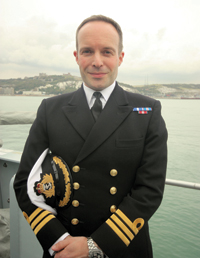The Type 23 frigate HMS Kent emerged from a multi-million pound upgrade at Rosyth towards the end of 2011 and Patrick Boniface met up with her commanding officer, Commander Ben Ripley, when the frigate visited her namesake county, to discuss his career and his command.
Why did you choose a career in the Royal Navy?I have no naval background at all, but it seemed to be something different, enjoyable and fun. I went into the Navy straight after leaving college, having done my A levels, and I was then into the Navy at 18. It was about getting out and seeing the world, which is what I did. I’ve been all around the world with the Navy, and seen pretty much everywhere apart from Australia.
What is the attraction of a life at sea for you?I don’t really know. I just enjoy being there and in command, which is what every warfare officer joins the navy to do, I think – I know I certainly did. All the other jobs, while they’re great in themselves, are leading towards it and gaining experience so it’s all part of the process of learning. There’s a real satisfaction in a job well done at sea where you’re on your own and relying on your ship. And the ship is very capable, but you certainly have tomould what you do and how you useit to every situation. I think that is the challenge.

Part of your job is to lead and inspire the ship’s company; how do you do that?You’ve got to give them as much responsibility, I think, and acting up to the next level in effect to give them as much of a free rein as you can, but with the appropriate levels of supervision and guidance, and let them feel empowered and learn and generate a thirst for moving on.
What is the hardest part of your job?A lot of it is challenging, but probably the hardest part is being away from families for long periods of time. We joined the Navy and love what we do, but we still find being away from loved ones a trial sometimes.
You started your career with the Royal Navy as a hydrographer: was this a posting or did you choose this route?I chose to go there originally, as it was something I thought would be an interesting first part to my career. I learnt a lot while I was there, but decided I wanted to come back to mainstream warfare, and fortunately theopportunity arose.
Which ships have you served on?HM survey motor launch Gleaner; we had a crew of about eight, which is interesting when you get an Admiral coming on board for the rededication ceremony and you can barely see the ship, and the ship’s company numbers about three. I navigated HMS Roebuck and was second navigator on HMS Scott, which we brought out of build and that saw my time out of the survey flotilla. I was only there for about six years.
You moved back into principal warfare roles as well as serving on and commanding minehunters.Indeed, that was just in command of minehunters. I had a team under me who did all the expert jobs on board. During my time there I commanded three Sandown class ships, HMS Penzance, HMSRamsey and HMS Pembroke.
Tell me about HMS Kent and her weapons upgrade.We got the new Mark 8 Mod 1 Kryten 4.5-inch gun, upgrades to most systems, including the ship’s combat system, some new close range weapon systems for protection, and the main item was Sonar 2087, the low frequency active sonar and the Merlin helicopter capabilityto go with it. We all hope not to have to use them in anger but we will certainly be using them on exercisesand partnering with our alliesand other navies.
What is the best part of your job?That’s easy – it’s the privilege of being in command of a Royal Navy ship as a captain, something I have worked for over 20 years to achieve.

Read A View From The Bridge every month in Ships Monthly – subscribe here


